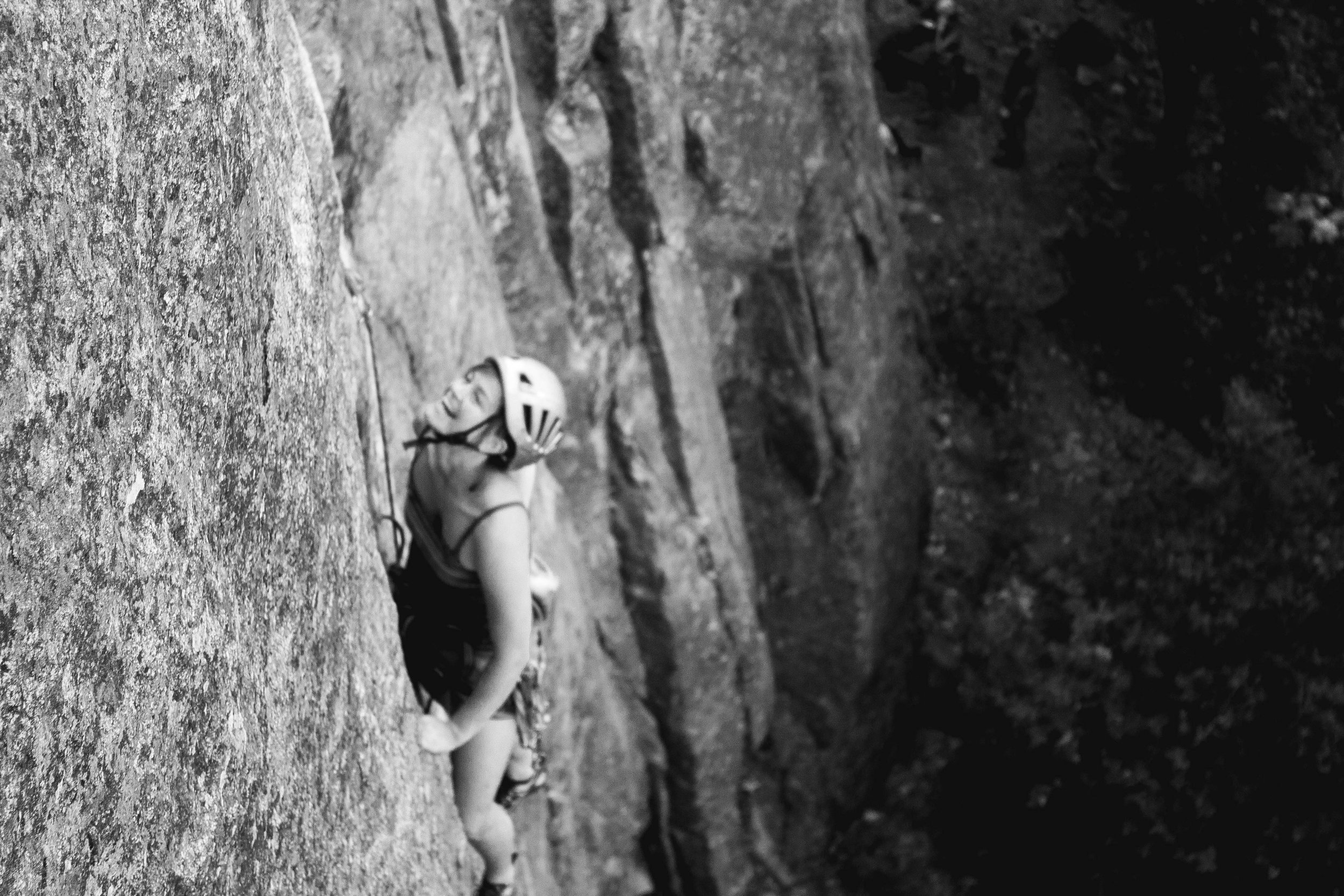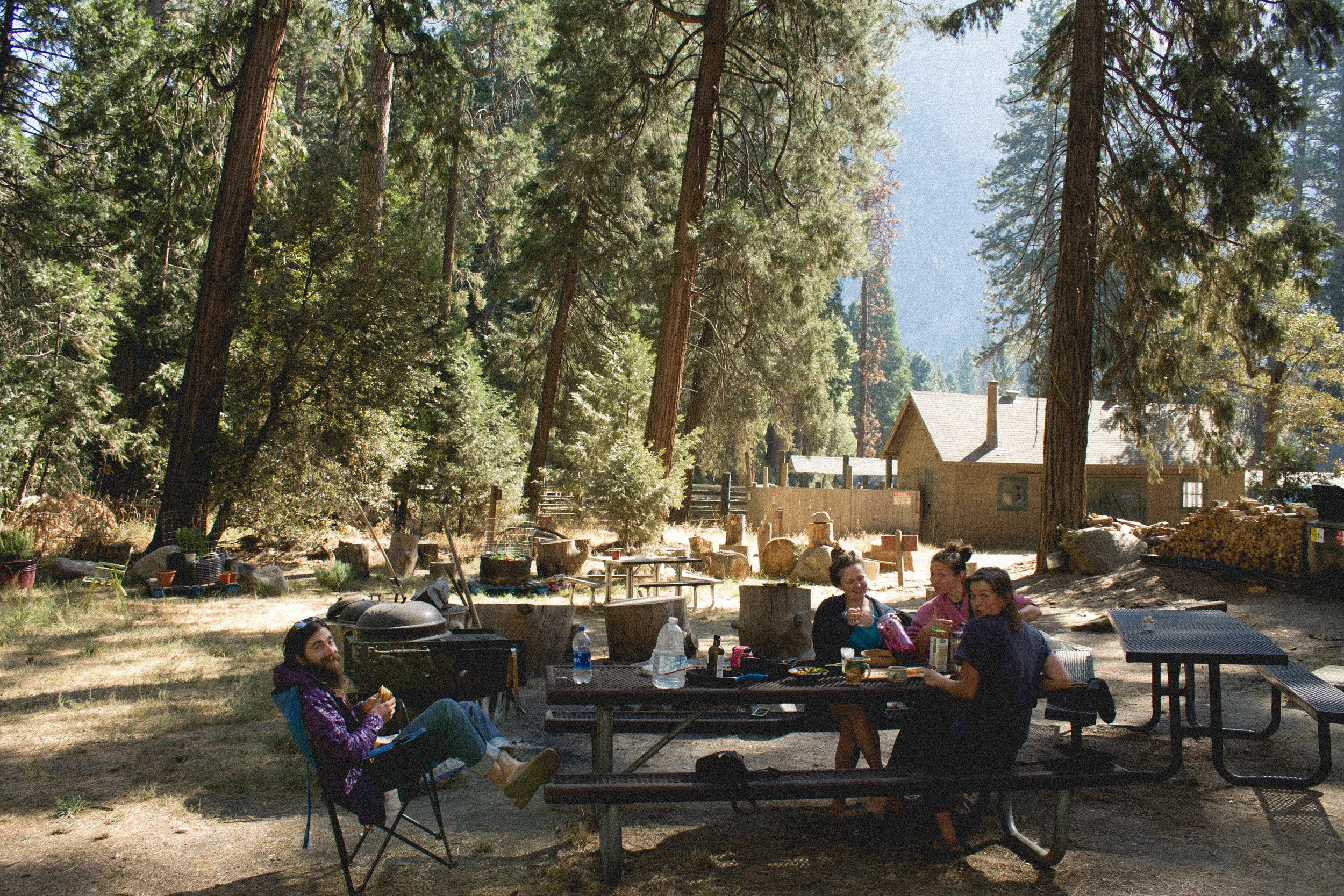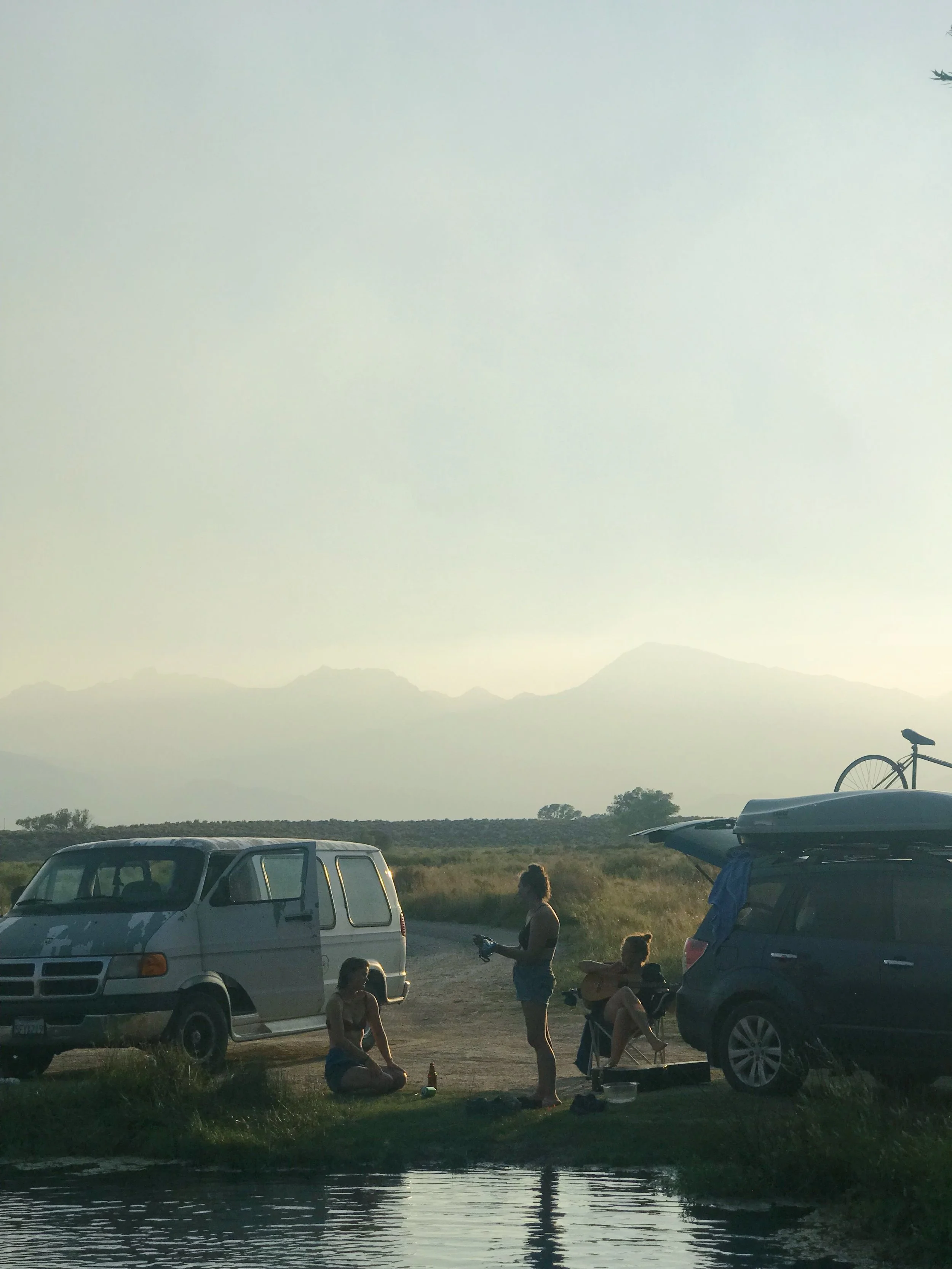






Completed Peaks & Routes
Cathedral Peak (5.7) - III, 2 solo
Tenaya Peak (5.5) - IIII, 3 solo
Matthes Crest (5.8) - South to North
Crystal Crag - North Arete (5.6) - solo
West Pillar of Eichorn Direct (10b)
Reg. Route on Fairview Dome (5.9)
Direct Northwest Face of Lambert (10b/c)
Crescent Arch (10b)
Cooke Book (10a)
North Peak to North Ridge of Conness (5.6) solo
Northeast Ridge of Bear Creek Spire (5.5) solo
Southeast Face of Mt. Emerson (5.4) solo
Red Dihedral on the Incredible Hulk (10b)
Third Pillar of Dana (10b)
Crying Time Again (10a R)
Lucky Streaks (10c/d)
OZ to Gram Traverse (10d)
Southeast Face (Harding Route) on Conness (10c)
Hobbit Book (5.7R)
It’s 90 degrees. Town shimmers with dry heat, asphalt melts, and you can’t sleep in. But a warm breeze blows and we lounge languid and bare-limbed next to a bubbling cool spring.
Smoke gathers in the distance, shrouding the sierra in a purplish, grey haze. My friends are displaced from their home, the fire burning on every road leading into the valley. But we’re lucky enough to be able to laugh and camp comfortably in our vehicles, making dinner and smoking spliffs under a surprisingly clear night sky.


I never thought I’d say it. I hold tightly to my New York driver’s license, presenting it proudly when asked for ID. I cling to the distilled New Yorker identity — intellectual, drinker of copious amounts of coffee, fast walker and aggressive driver. But here I am, four years after flying West on a one-way ticket to San Francisco, utterly smitten with the golden state. I find myself softening around the edges in the warm sun, enjoying my year-round bronzed skin, and relishing in the fact that I can drive a few hours in any direction and be somewhere new — the rolling vineyards and green hills of the coastal mountains, lush with the moist ocean breeze. The deserts of the South — with lunar landscapes of beige, and spindly plants that stretch their arms towards the starry night sky. Or the snow-capped peaks of the Sierra Nevada, with soaring granite mountains and ridgelines and meadows of wildflowers, crystalline lakes. Californ-i-a.
I often think about leaving. As there are so many places yet to see on this star-spangled, great wide expanse. I’m often anxious about these places — what if one of them is perfect for me? Has everything I want to settle down, the perfect home, the perfect community, the perfect ratio of culture and the outdoors. I grow frantic with these thoughts. But every time I think about leaving I find that I just can’t. Not right now anyways. I feel that after four years I’ve finally just brushed the surface of the community I’ve always wanted to be a part of. The dirtbags of Yosemite Valley and the Eastern Sierra — with their myriad of climbing accomplishments and skills but all with the same dream — living here forever. Amongst the sage brush and sand, at the base of those blue-grey giants, the infinite playground, the harbors of mountain fantasy.
And so for now, I stay. And New York seems like a forgotten dream.

I looked up at the sky, watching the clouds gather above me in a dark mass. “Oh shit,” I thought to myself as I picked up my pace, running down trail on a wide, sandy plateau at 11,000 ft. A perfect place for lightning to strike. I’d done some solo-ing before. Tenaya Peak was a regular circuit of mine this summer, as I found myself with swaths of free time between waiting tables and no climbing partners. But this was my first big day alone in the mountains. I vaguely tried to recall if I had told anyone where I was going, and often had images of Aaron Ralston screaming alone in a canyon with his arm fatally stuck in a rock from the movie 127 Hours. I trip a lot when I’m hiking. For some reason, I come embarrassingly close to rolling my ankle more than once on an approach or descent. “God damn you’re a klutz,” a comment I’ve tried to deny more than once. But when I lace up my climbing shoes, everything slows down — I am careful and in control, choosing each step wisely, making each move with confidence, always checking the quality of the rock I’m about to grab and trust with my life. Because when you’re entirely alone at 12,500 ft, miles from the road, there’s no room for error.
For eight hours I saw no one. For eight hours I was making my own calls, choosing when to rest and when to press on, route-finding, back-tracking, scrambling, pulling low fifth-class moves. I like being alone — for the sense of accomplishment it gives me, for the knowledge that I am choosing to challenge myself with something serious. It makes me feel that I have breached a new level of climbing — that I am confident enough in my own abilities to navigate mountain terrain, which to me proves more than ticking off a hard route at a crag.
The dark clouds dissipate as I make my way off the sandy plateau on the south side of Mt. Conness. I put on a favorite song, plug in my headphones, and float the last five miles back to the car.


The clouds lately — huge, like freshly frothed whipped cream, pile after frothy pile. At first the tableau is modernist — a solid blue hue of a sky with cartoon-like puffs and whisps. As the hour draws closer to three, we rewind a couple hundred years to the romantic period. With dramatic gold and rose beams slanting through foggy gaps, in between towering, gathered condensation that look as majestic as thrones for the gods. All grey and dense and full of electric energy, claps of thunder.
It’s something else — driving 20 miles up and over the pass and watching how dramatically the mountains dictate the weather. One mile it’s pouring rain and I’m hunched over my steering wheel trying to see through the flood, and the next it’s sunny skies — all petrachor and dewy freshness.
These thunderstorms are the stuff of youth — real and imagined — of hiding under blankets in my living room, listening to the thunder crackle and boom and hearing the rattle of our long, flimsy glass bay windows. Or running out onto the porch, barefoot and screaming as the rain comes down in sheets, wind whipping through the trees.
Almost made the drive from Bishop in a day. Pulled over at a viewpoint two hours outside of Moab so I could savor the desert views in the morning. They didn’t disappoint — a pink and orange sunrise and piles of sandstone.
Indian Creek was different than I imagined it would be.
More vast, maybe.
I imagined more color, I think, more striking reds and oranges, contrasting blue sky like a painting of primary colors, with silhouettes of hawks like black cut-out pieces.
But it’s kind of like Joshua Tree in that way — everything seems vast and slightly hard to grasp from far away but as soon as you get close, shapes appear in a fascinating display of geometry and spatial relationships — oblong rocks resting on big blocks of granite, or sharp corners with jagged white cracks like lightning bolts in a red sky.
Gravel moves roughly underfoot. Each step slightly unbalanced, my ankles roll on the uneven terrain and I know I’ll pay for it later. In front of us, about a quarter mile ahead is a braided river. Its swiftly moving streams snake through the rocky landscape, thinning and widening, twisting and turning. We approach it, groaning as we peel off our boots and put on our “creek shoes”: mine a pair of worn Nike’s, and step gingerly into our fast-moving braided creek of choice, bracing ourselves against the current and the icy, icy cold, a cold so cold I fight back a scream of shock and agony. Glacier water, kids, it’s no joke. But as soon as it starts it’s over, and we laugh and take our time putting our socks and boots back on, warming ourselves in the warm July, Alaskan sun.
Backpacking in the wilderness surrounding Denali challenges the average hiker with the truth of its stark reality–you sign up for a backcountry permit at a ranger station where the quota board breaks up the park into units with a limit to the number of people permitted in each. The max number is usually four. The idea is to provide everyone with the greatest degree of wilderness as possible. No trails, signs, water stations, trashcans, bathrooms, ranger stations, or cell phone service. Nothing but you and the wild–the grizzlies, the caribou and golden eagles, rushing glacial rivers and their gravel beds, grassy ridgelines and icy moraines, tarns and waterfalls and lakes, marmots and wildflowers and dall sheep, and of course, the ever-present Denali herself, looming like a goddess in her veil of clouds.
I spent the summer in Denali climbing steep ridgelines instead of climbing granite walls back in the sun-drenched valleys of California. I gained a new appreciation of cross-country travel, moving awkwardly over unknown terrain instead of pushing my abilities on steep cliffs, blistering my feet instead of my hands, growing tough skin in new places. I tried to decipher the delicate lines on topographical maps that examined the vast horizontal instead of the vertical, route finding of a different sort.
These mountains changed my idea of what the word “vast” even meant. Their sheer size, ruggedness, remoteness, all taunting us from afar, “you’re not good enough for us yet” they seemed to shout at me. I wanted to be good enough for those mountains, and I vowed that the next time I was in Alaska, I would be. This time instead, I would cover as much ground as I could on foot, determining for myself what a long day of hiking under the midnight sun was like, and growing stronger with each gravely step. On many of our trips, Denali unveiled herself for us, a rare sight. There’s something truly inspiring about hiking around the foothills of a mountain like that, covering the ground in her shadow, and snaking your way ever so slowly towards the base, imagining, that one day, you’ll ascend.



We reached the top of the first pitch, and looked at each other knowingly. “Let’s bail,” I said, and we coiled our rope and headed for the rap station as the sun hid itself behind Middle Cathedral across the valley, and a dreary, soul-sucking cold consumed the afternoon. The truth is, I hadn’t had much fun climbing that first pitch. My toes were freezing in my climbing shoes, which sent a chill of terror through my body as I made unprotected face moves without being able to feel my feet. Snow still lay on the valley floor from winter storms the week before, and the days had been dark and grey, but I was determined to climb something, anything, at the first opportunity. But with dismay, I decided to cut my losses that day, and watched as the sky darkened to a somber shade of grey, and a crow cawed on a dead tree and flew away.
During the first turning of autumn, when the resplendent leaves finally lay to rest on the cold ground, when the days become dramatically short, darkness and cold descending with remorseless rapidity, and the stirring of the wind shocks all life into submission, I always grow weary, not yet ready to battle for warmth through the long dark months ahead. The first month of winter is always the worst. Summer’s touch still lingers in my mind, and I convince myself that I need rays of sunlight to motivate me, and use this as an excuse as I crawl into bed instead of outside. Day after day of overcast skies cast shadows over my mood, and seem to meld together in a palate of grey. Where summer days are so distinct and lively and full of dazzling light, winter days lull me into a state of hazy complacency.
At first, I try and fight this mood. But eventually, the cold settles itself in my bones, and I realize that winter demands a slower pace. The trees and plants shrink and settle, quietly statuesque in their blanket of snow, animals stay active seeking food and shelter, or slow their metabolisms. So we must also adapt to this change – to slow down ourselves, take time to reflect on the busy seasons past and the new year that comes ahead, to use the shorter days to rest more fully, more deeply, as our bodies crave after a summer and fall of going, going, going. To realize that it’s ok to bail, that it’s ok to spend days inside reading books and drinking tea instead of going big and getting after it. That seasons enforce a necessary cyclical rhythm, and we must listen to its suggestions. Take time to rest, for what’s coming next.
